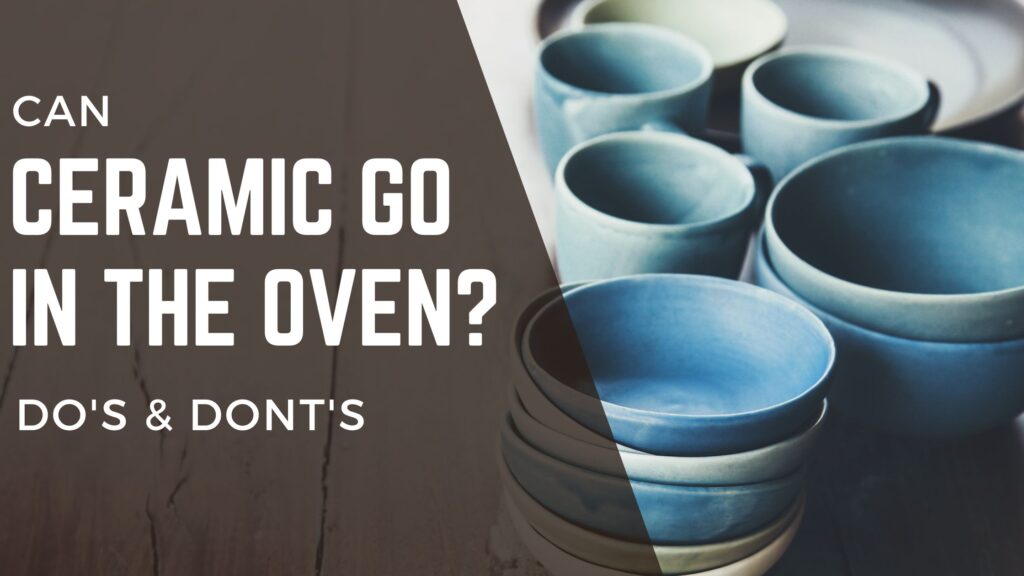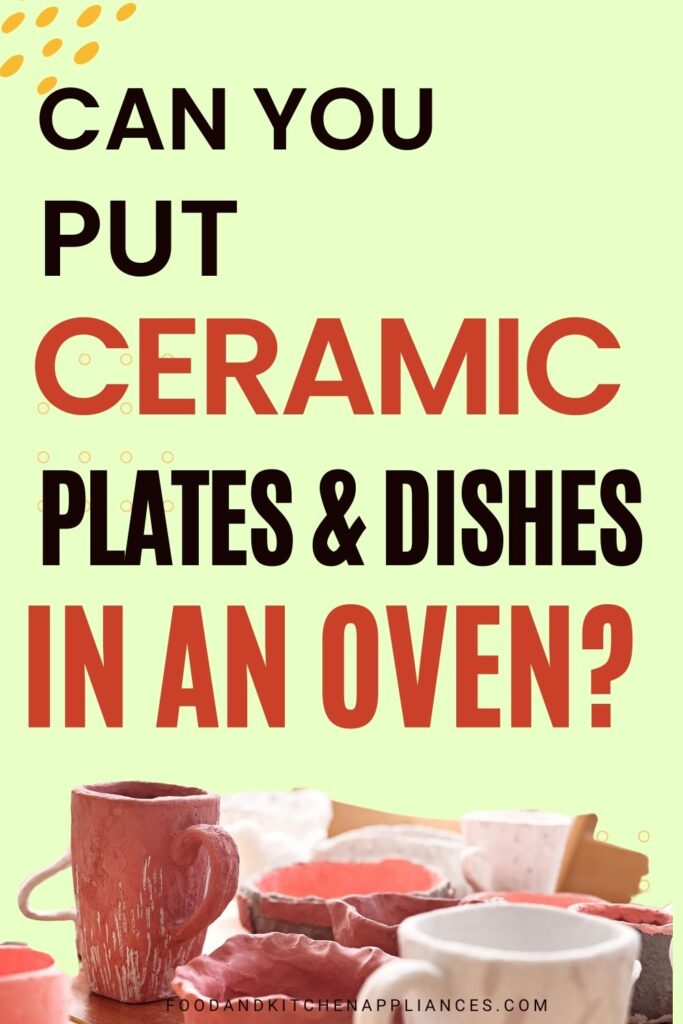Are you wondering if you can use your ceramic cookware in the oven? The answer is yes, but it depends on the specific type of ceramic cookware you have. While some ceramic cookware is oven-safe, others are not, and using the wrong type of cookware in the oven can lead to damage or even breakage.
When using ceramic cookware in the oven, it’s essential to check the manufacturer’s instructions or label to determine if it is oven-safe. Some ceramic cookware may have a temperature limit for oven use, while others may not be suitable for use in the oven at all.
Additionally, it’s important to preheat your ceramic cookware with the oven to avoid thermal shock, which can cause it to crack or break.

Can Ceramic Cookware be Used in the Oven?
Yes, Ceramic cookware is durable and can withstand high temperatures, making it perfect for oven use. When using ceramic cookware in the oven, it’s essential to check the manufacturer’s instructions or label to determine if it is oven-safe. Some ceramic cookware may have a temperature limit for oven use, while others may not be suitable for use in the oven at all.
There are a few factors to consider when using ceramic cookware in the oven.
Factors to Consider
Before using your ceramic cookware in the oven, it’s essential to check the manufacturer’s instructions to ensure it is oven-safe. Most ceramic cookware is oven-safe, but it’s always best to double-check.
Another factor to consider is the temperature limit of your ceramic cookware. Different types of ceramic cookware have different temperature limits, so you need to ensure that you don’t exceed the temperature limit of your cookware.
Exceeding the temperature limit can cause your cookware to crack or break.
How to Use Ceramic Cookware in the Oven
To use your ceramic cookware in the oven, follow these steps:
- Preheat your oven to the desired temperature.
- Place your ceramic cookware in the oven.
- Cook your food according to the recipe instructions.
- When your food is ready, remove the ceramic cookware from the oven using oven mitts or pot holders.
It’s important to note that ceramic cookware retains heat, so it will continue to cook your food even after you remove it from the oven. To prevent overcooking, remove your food from the ceramic cookware as soon as it’s done.
What is Ceramic Cookware?
Ceramics may be the way to go if you want a versatile, durable, stylish cookware option. It is made from clay fired at high temperatures to create a rigid, non-porous surface. This surface is coated with a non-stick material to make cooking and cleaning easier.
Types of Ceramic Cookware
There are several types of ceramic cookware available on the market today. Here are a few of the most popular types:
- Glazed Ceramic Cookware: This type of ceramic cookware is coated with a layer of glaze that makes it easy to clean and gives it a glossy, attractive finish. Glazed ceramic cookware is available in various colors and styles to match your kitchen decor.
- Unglazed Cookware: Unglazed ceramic cookware has a more natural, rustic look than glazed ceramic cookware. It is also more porous, making it more susceptible to staining and absorbing flavors from food. However, unglazed ceramic cookware is often more affordable than glazed ceramic cookware.
- Ceramic-Coated Cookware: Ceramic-coated cookware is made from a base material such as aluminum or stainless steel, then coated with a ceramic layer. This type of cookware combines the durability and heat distribution of the base material with the non-stick properties of ceramic.
Uses of Ceramic
It is a versatile material with many uses in the kitchen. Here are some of the ways you can use ceramic cookware in your oven:
Baking
Ceramics is an excellent material for baking. It heats evenly and retains heat well, making it ideal for baking cakes, bread, and other baked goods. Ceramic baking dishes come in various shapes and sizes, so you can find one that suits your needs.
Roasting
Ceramic is also excellent for roasting meats and vegetables. The material distributes heat evenly, so your food will cook evenly. Ceramic roasting dishes are available in different sizes, so you can choose one that fits your oven and the amount of food you want to cook.
Serving
Ceramic dishes are not only functional but also aesthetically pleasing. They come in various colors and designs, so you can choose one that matches your kitchen decor. Ceramic serving dishes are perfect for presenting your food at the table.
Storing
Ceramic dishes can also be used for storing food in the fridge or freezer. They are durable and can withstand temperature changes, so you can use them to store leftovers or meal prep for the week.
Other uses
This type of cookware can also be used for other purposes, such as:
- Cooking soups and stews
- Making casseroles
- Steaming vegetables
- Grilling
Ceramic dishes are a great choice whether baking, roasting, serving, or storing food. Just be sure to choose oven-safe ceramic cookware and follow the manufacturer’s instructions for use and care.
Precautions When Using Ceramic Cookware in the Oven
When using ceramic cookware in the oven, it is essential to take certain precautions to ensure it does not crack or break. Here are some things you should keep in mind:
Avoid Thermal Shock
It can crack if exposed to sudden changes in temperature. This is known as thermal shock. To avoid thermal shock, you should:
- Preheat the oven before placing the ceramic cookware inside.
- Do not place the ceramic cookware directly on a hot stovetop or burner.
- Do not place the hot ceramic cookware on a cold surface, such as a countertop or sink.
- Do not immerse hot ceramic cookware in cold water.
Avoid Abrasive Cleaners
Abrasive cleaners can scratch the surface of ceramic cookware, making it more prone to cracking or breaking. To avoid damaging your ceramic cookware, you should:
- Use a soft sponge or cloth to clean the cookware.
- Avoid using steel wool or other abrasive materials.
- Use a non-abrasive cleaner designed for use on ceramic cookware.
By following these precautions, you can help ensure that your cookware remains in good condition and lasts many years.
Are Ceramic Mugs Oven-Safe?
If you wonder whether ceramic mugs are oven-safe, the answer is yes, but with some caveats. Ceramic mugs are generally safe to use at high temperatures, but you need to ensure they are made of high-quality ceramic and are marked as oven-safe.
There are a few things to remember when using mugs in the oven. First, avoid placing the mug directly on the heating element or open flame. Doing so can cause the mug to crack or shatter. Instead, place the mug on a baking sheet or oven-safe dish to distribute the heat evenly.
Second, use caution when handling hot mugs. Ceramics is a good insulator, which means the mug will retain heat for a while after it is removed from the oven. Use oven mitts or a towel to handle the mug, and avoid touching the hot surface directly.
Third, check the base of the mug for a marking that indicates it is oven-safe. If the mug is not marked as oven-safe, avoiding using it in the oven is best.
Overall, the mugs can be an excellent option for baking individual servings of desserts or casseroles. Just follow these guidelines to ensure a safe and successful baking experience.
| Pros | Cons |
|---|---|
| Can withstand high temperatures | Can crack or shatter if placed directly on the heating element |
| Good insulator | Retains heat for a while after removing from the oven |
| Oven-safe if marked | Not all ceramic mugs are oven-safe |

Can Ceramic Bowl Go in the Oven?
If you wonder whether your ceramic bowl is safe in the oven, the answer is “it depends.”
Most ceramic bowls can withstand high temperatures, but you must check the label or packaging to confirm. If the packaging doesn’t clearly state that the bowl is oven safe, you can look for an image on the bottom.
Wavy lines below 300 degrees Fahrenheit mean the bowl can be used in low-temperature ovens. In contrast, a picture of an oven with a temperature range indicates the bowl can be used in high-temperature ovens.
However, even if your bowl is labeled oven-safe, it’s important to note that not all ceramic bowls are created equal. Some ceramic bowls are more durable and can withstand higher temperatures than others.
Following the manufacturer’s instructions is essential when using a high-temperature ceramic bowl. For example, some bowls may require preheating before use to prevent cracking.
It’s also essential to avoid sudden temperature changes, such as placing a cold ceramic bowl in a hot oven or removing a hot bowl from heat and placing it in cold water. These sudden temperature changes can cause the bowl to crack or even shatter.
In summary, most ceramic bowls are oven safe, but it’s essential to check the label or packaging and follow the manufacturer’s instructions. Avoid sudden temperature changes and carefully handle your ceramic bowl to prevent damage.